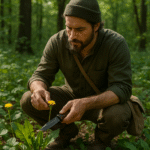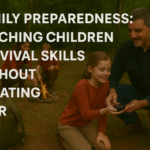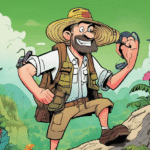Are you prepared for the unexpected? In today’s fast-paced world, it’s crucial to possess basic survival skills that can be utilized in various situations. Whether you find yourself lost in the wilderness, facing a natural disaster, or simply wanting to be self-sufficient, mastering these essential simple survival skills is an invaluable asset. This article will provide you with a comprehensive guide on a range of vital techniques that everyone should know.
Within these pages, we will delve into the art of shelter building, teaching you how to construct temporary havens using natural materials found in your surroundings. We will also explore the skill of fire making, enabling you to harness this elemental force for warmth, cooking food, and signaling for help when needed. Additionally, we will uncover methods for ensuring clean water through various purification techniques, as well as imparting navigation skills to help you confidently traverse unfamiliar terrain.
That’s not all – we’ll also equip you with first aid techniques tailored specifically for survival situations and introduce you to the basics of foraging for wild edibles. And finally, we’ll share tips on food preservation so that your rations can last longer during times of scarcity.
By the end of this article, you’ll feel empowered and ready to face any challenge that comes your way. So let’s embark on this journey together as we unlock the secrets of essential simple survival skills!
The Art of Shelter Building
When venturing into the wilderness, one of the first and most crucial skills to master is the art of shelter building. In harsh environments where survival is at stake, a well-constructed shelter can be the difference between life and death. Not only does it provide protection from extreme weather conditions, but it also offers a sense of security and comfort.
There are various types of shelters, each suited for different terrain and climates. The classic lean-to is a simple yet effective option, utilizing natural materials such as branches and foliage to create a sturdy framework. Alternatively, a debris hut involves constructing a structure using leaves, twigs, and other debris to form an insulated cocoon against the elements.
The process of shelter building requires careful consideration of location, orientation, and available resources. It is essential to select an area that provides adequate protection from wind and precipitation while being easily accessible for gathering firewood or water sources. With resourcefulness and ingenuity as your guiding principles, constructing a well-crafted shelter not only ensures survival but also fosters a deep connection with nature’s abundance.
Mastering the Skill of Fire Making
Fire is not only a source of warmth and light; it is also a symbol of survival, resilience, and human ingenuity. Mastering the skill of fire making is essential for anyone venturing into the great outdoors. Whether you are stranded in the wilderness or simply enjoying a camping trip, knowing how to start a fire can be life-saving.
To begin with, understanding the importance of fire safety cannot be overstated. Before attempting to create a fire, ensure you have a designated area clear from flammable materials. Gather three types of fuel: tinder (small, dry materials that easily catch fire), kindling (slightly larger sticks), and fuelwood (larger logs). Properly arranging these elements will facilitate ignition and maintain your fire’s longevity.
Now that you have prepared your site and gathered your fuel, let’s delve into various fire-making techniques. The most basic method involves using friction to create an ember. By rapidly rubbing together two pieces of dry wood or using a bow drill or hand drill technique, the friction generates enough heat to ignite your tinder bundle. Patience and perseverance are key here; it may take several attempts before achieving success.
Ensuring Clean Water Through Purification Methods
When it comes to survival, one of the most critical aspects is ensuring a clean and reliable source of water. In a wilderness setting, finding drinkable water may not always be an easy task. Fortunately, there are various purification methods that can help you quench your thirst and stay hydrated in even the most challenging circumstances.
The first method to consider is boiling. Boiling water is perhaps the oldest and most reliable way to kill bacteria, viruses, and parasites that could cause waterborne illnesses. Simply bring the water to a rolling boil for at least one minute (or longer at higher altitudes), allow it to cool, and it will be safe to drink. This method is simple yet effective, requiring only a heat source and a container.
Another valuable purification method is using filtration systems or devices. These range from portable filters with built-in membranes to devices equipped with activated carbon. Filtration removes impurities by physically straining out particles, bacteria, and protozoa from the water. Some advanced filters even have the capability of removing chemicals like chlorine or heavy metals present in contaminated sources.
Navigating the Wilderness with Confidence
When venturing into the wilderness, possessing the skill to navigate effectively is of paramount importance. The ability to find your way through uncharted territory not only ensures your safety but also instills a sense of confidence and self-reliance. To become a proficient wilderness navigator, one must understand the art of map reading and compass usage.
Map reading is an essential skill that enables you to interpret topographic maps, understand contour lines, and identify prominent landmarks. By studying these maps beforehand, you can familiarize yourself with the terrain, plan alternative routes, and anticipate potential obstacles. Additionally, carrying a reliable compass allows for precise navigation when encountering unfamiliar landscapes or when visibility becomes impaired.
Remember that nature offers its own navigational signs as well. Cloud formations can reveal impending weather changes while the position of the sun serves as an excellent reference for direction during daylight hours. Familiarizing yourself with natural indicators such as moss growth on trees (which tends to be denser on the northern side) can further assist in determining your bearings.
First Aid Techniques for Survival Situations
When venturing into the great outdoors, it is crucial to be equipped with basic first aid knowledge to handle unexpected situations. In survival scenarios, where medical professionals are often far away, having a solid understanding of first aid can mean the difference between life and death. This section will explore essential first aid techniques that can empower individuals to take immediate action and provide necessary care in critical situations.
1. Assessing and Stabilizing Injuries
In an emergency situation, the ability to quickly assess injuries and provide immediate stabilization is paramount. Taking a calm and systematic approach, begin by evaluating the individual’s overall condition – check their airway, breathing, and circulation (ABCs) before moving on to specific injuries. From minor cuts and sprains to more severe wounds or fractures, knowing how to dress wounds properly with available resources, immobilize fractures using splints or improvised materials like sticks or branches, can significantly minimize further damage.
Furthermore, understanding how to manage bleeding effectively by applying direct pressure or using tourniquets (as a last resort) is crucial. Remember that staying calm while providing reassurance can greatly alleviate panic and stress for both yourself and the injured party.
2. Treating Common Outdoor Ailments
Surviving in nature exposes us to various environmental factors that may lead to common ailments such as insect bites/stings, sunburns, dehydration, or mild hypothermia. Knowing how to manage these conditions is vital in ensuring comfort and preventing further complications.
An important skill is identifying poisonous plants like poison ivy or poison oak so as not to aggravate skin irritations caused by these plants upon contact. Additionally, understanding how to properly remove ticks or splinters reduces the risk of infection. Treating sunburns with aloe vera or wearing protective clothing to prevent them in the first place is necessary for maintaining skin health.
Lastly, recognizing the symptoms of dehydration and mild hypothermia, and addressing them promptly through rehydration and rewarming techniques, respectively, can prevent potentially life-threatening situations from escalating.
3. Administering CPR and Basic Life Support
In critical emergencies such as cardiac arrest or near-drowning incidents, knowing how to perform cardiopulmonary resuscitation (CPR) and basic life support (BLS) techniques can be truly lifesaving. CPR involves chest compressions, rescue breaths, and defibrillation if an automated external defibrillator (AED) is available.
Proper training in CPR equips individuals with the skills to maintain blood circulation and oxygenation until professional medical help arrives. By staying calm under pressure and having confidence in your abilities to provide immediate assistance, you become an invaluable asset in increasing survival chances for those in need.
In summary, acquiring knowledge of first aid techniques is essential for anyone venturing into the wilderness. Being prepared to assess injuries properly, manage common outdoor ailments effectively, and administer CPR/BLS can mean the difference between life and death during critical situations. By gaining these skills, individuals can embark on their outdoor adventures with confidence while ensuring their safety as well as that of others around them.
Gathering Wild Edibles: The Basics of Foraging
Exploring the bountiful offerings of nature through foraging can be a truly enlightening and empowering experience. As humans, we have evolved alongside the natural world, and our ancestors relied heavily on their ability to gather wild edibles for sustenance. Today, while we may have easy access to supermarkets and convenience stores, reconnecting with this ancient skill can provide us with a sense of self-sufficiency and a deeper appreciation for the natural world.
When venturing into the realm of foraging, it is crucial to start with a solid foundation of knowledge. Familiarize yourself with local plant life, identifying common edible species that thrive in your region. A field guide or an experienced forager can be invaluable resources in helping you differentiate between safe plants and potentially harmful ones.
It is essential to remember that sustainable foraging practices are key to preserving our ecosystems. Forage responsibly by following these guidelines: only harvest what you need, avoid taking endangered or protected species, respect private property rights, and never disturb delicate habitats. By adopting these principles, you not only ensure the longevity of the plants but also leave room for future generations to enjoy the benefits of foraging.
Food Preservation: Making Your Rations Last
Amidst the uncertainties of survival situations, ensuring a stable food supply becomes paramount. Learning the art of food preservation can be a lifesaving skill that will keep your rations fresh and nutritious for extended periods. By employing various preservation techniques and utilizing the resources found in nature, you can maximize the longevity of your provisions.
One effective method of preserving food is dehydration, which removes moisture from edibles, inhibiting bacterial growth and spoilage. Dehydrating food is relatively straightforward; simply slice fruits, vegetables, or even meats into thin pieces and let them air dry in a well-ventilated area or use a dehydrator if available. The result is lightweight, compacted sustenance that retains its nutritional value for an impressively long time.
Canning is another tried-and-true technique for prolonging the shelf life of perishable goods. By sealing food inside airtight jars after heating it to high temperatures, you create an inhospitable environment for bacteria or mold growth. The beauty of canning lies in its versatility—it allows you to preserve various types of foods such as fruits, vegetables, soups, and even meats. Imagine opening a jar months later and savoring the taste of freshly preserved produce that reminds you of sun-drenched fields and abundant harvests.
Conclusion
In conclusion, mastering essential simple survival skills is not merely a matter of preparedness, but a gateway to self-reliance and empowerment. By honing the art of shelter building, fire making, water purification, wilderness navigation, first aid techniques, foraging for wild edibles, and food preservation methods, individuals become equipped to face unexpected challenges with confidence. These skills not only provide practical solutions in dire situations but also foster a deeper connection with nature and instill a sense of resilience that transcends the wilderness. Embracing these skills opens up a world of possibilities for personal growth and an appreciation for the inherent strength that lies within us all. As we navigate through life’s uncertainties, let us remember that by cultivating these survival skills, we can embrace our inner survivor and emerge stronger than ever before.







